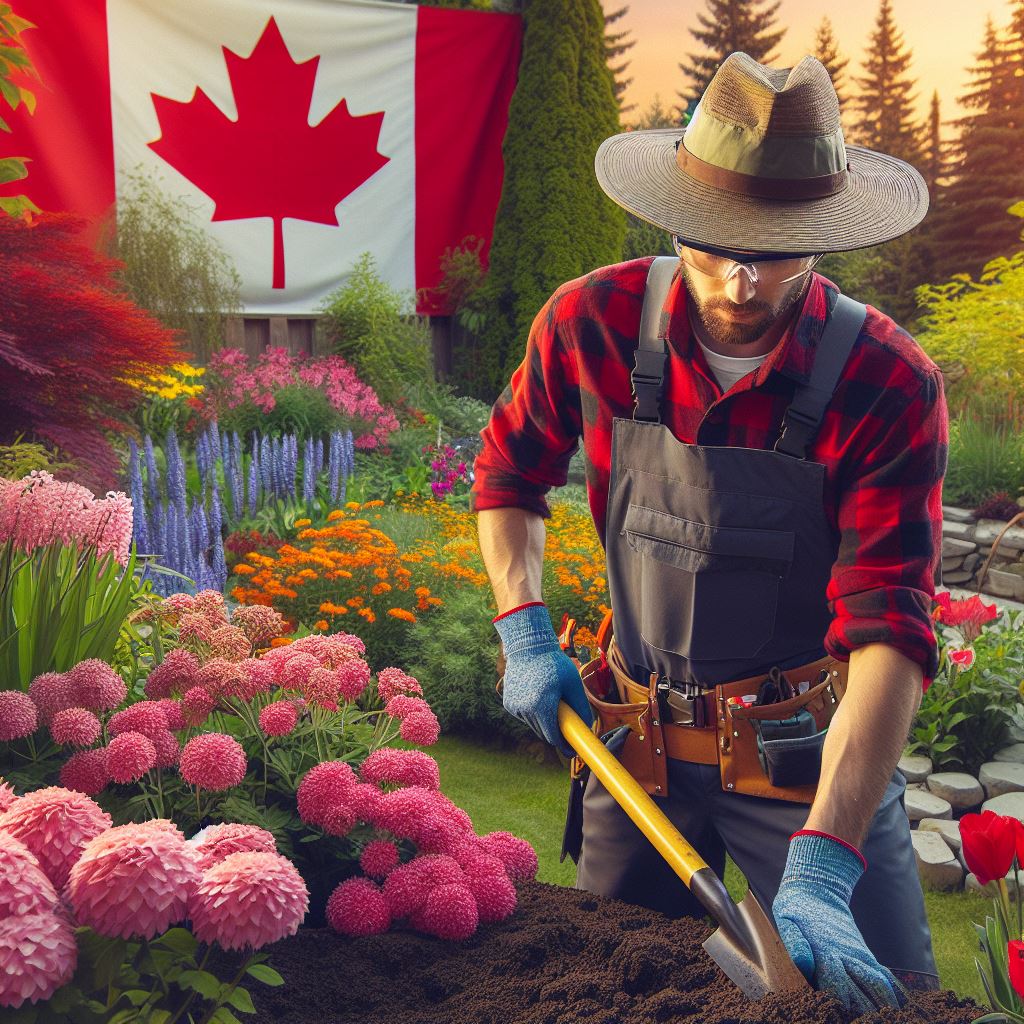Introduction
Garden design is an essential aspect of landscaping that can significantly enhance the value and appeal of a property.
A well-designed garden can create a sense of space and tranquility, making it an ideal place for relaxation and entertainment.
In this blog post, we will provide you with an overview of the importance of garden design and how it can benefit you and your home.
Canadian context and unique characteristics
Canada, with its diverse climate and vast landscapes, offers a unique gardening experience.
Weather, hardiness zones, seasons, and garden styles shape gardening in Canada.
Canadian garden styles are diverse, from formal gardens to contemporary urban spaces.
Some popular styles include formal gardens, native gardens, cottage gardens, and urban gardens.
In this blog post, we will discuss the importance of garden design and how it can benefit you and your home.
We will also provide you with information on how to create a garden that reflects your personality and style.
Our guide will cover everything from the basics of garden design to advanced techniques.
Whether you are a beginner or an experienced gardener, this blog post is for you.
So, let’s dive in and explore the art of Canadian garden design together!
Historical Influences on Canadian Garden Design
Indigenous gardening traditions
- Indigenous peoples of Canada have a rich history of gardening practices.
- They cultivated native plants like wild berries, corn, beans, and squash.
- Indigenous gardens were harmoniously integrated into the surrounding environment.
- Gardens were often created for both practical purposes and spiritual connections to nature.
- Traditional Indigenous gardens emphasized sustainability, biodiversity, and self-sufficiency.
- Indigenous gardening techniques included companion planting, crop rotation, and natural pest control.
- The respect for land and the intimate knowledge of plants shaped their unique gardening traditions.
European influences brought by early settlers
- The arrival of European settlers in Canada had a significant impact on garden design.
- European settlers brought with them their own horticultural knowledge and gardening practices.
- Formal European garden styles, such as French, English, and Italian, began to influence Canadian garden design.
- English cottage gardens became popular, characterized by a mix of herbs, perennials, and annuals.
- The formal gardens of Versailles served as inspiration for grand estates in Canada.
- Gardens became a status symbol, demonstrating wealth and social standing.
- The introduction of new plants, such as roses, tulips, and lilacs, enriched Canadian gardens.
Development of gardening societies and horticultural shows
- The establishment of gardening societies played a crucial role in shaping Canadian garden design.
- Horticultural societies provided a platform for garden enthusiasts to exchange ideas and knowledge.
- These societies organized horticultural shows, where gardeners showcased their achievements.
- Gardening shows became an opportunity to educate the public and introduce new plant varieties.
- They encouraged competition among gardeners, improving the overall quality of Canadian gardens.
- Horticultural societies also played a role in conservation efforts and promoting native plants.
- Today, gardening societies continue to foster a sense of community and provide resources for gardeners.
Generally, the art of Canadian garden design is influenced by a variety of historical factors.
Indigenous gardening traditions, European influences brought by early settlers, and the development of gardening societies all shape the unique Canadian garden aesthetic.
By understanding and embracing these historical influences, modern Canadian gardeners can create beautiful and meaningful gardens that reflect the country’s rich cultural heritage.
Read: Landscaping Certifications: What Canadians Need
Key Elements of Canadian Garden Design
Emphasis on native plants and biodiversity
- Native plants are crucial in Canadian garden design due to their ability to adapt to the local climate.
- By using native plants, Canadian gardens not only create a sense of place but also support local wildlife.
- Integrating a variety of plants can help increase biodiversity and create a more balanced ecosystem.
- Choosing plants that are well-suited to the local soil conditions can also reduce the need for fertilizers and pesticides.
- Native plants can add natural beauty to a garden while requiring less maintenance than non-native species.
Incorporation of water features and natural stone
- Water features, such as ponds or waterfalls, are commonly included in Canadian garden designs.
- These features not only enhance the visual appeal but also provide soothing sounds and attract wildlife.
- Natural stone elements, like pathways or retaining walls, blend with the surrounding landscape.
- Using locally sourced stones can further reinforce a connection to the Canadian environment.
- Water features and natural stone can create a harmonious and tranquil atmosphere in Canadian gardens.
Integration of seasonal color and texture
- Canadian gardens embrace the changing seasons by incorporating plants with vibrant colors and diverse textures.
- Spring blooms, summer foliage, autumn leaves, and winter berries create a visually dynamic garden year-round.
- Using a mix of evergreen and deciduous plants ensures that color and texture remain even during the colder months.
- Strategically placing plants with different flowering times can provide continual bursts of color throughout the seasons.
- By considering seasonal changes, Canadian garden design becomes a celebration of nature’s ever-changing beauty.
Creation of functional outdoor spaces
- Canadian garden design emphasizes the creation of outdoor spaces that can be enjoyed year-round.
- This includes features such as patios, seating areas, pergolas, or outdoor kitchens.
- A well-designed garden should allow for various activities, from entertaining guests to quiet relaxation.
- Consideration should be given to sun exposure, wind patterns, and privacy when designing functional outdoor spaces.
- Thoughtful placement of these elements ensures that Canadian gardens become an extension of the home’s living space.
Essentially, Canadian garden design incorporates key elements such as native plants and biodiversity, water features and natural stone, seasonal color and texture, and functional outdoor spaces.
By showcasing local flora, creating a sense of harmony with natural elements, celebrating the changing seasons, and providing functional areas for outdoor enjoyment, Canadian gardens reflect the beauty and practicality of living harmoniously with nature.
Read: Starting Your Landscaping Business in Canada
Popular Styles in Canadian Garden Design
English Cottage Gardens
English Cottage Gardens are a popular style in Canadian garden design.
These gardens are known for their romantic and whimsical atmosphere.
They typically feature a mix of flowers, herbs, and vegetables, arranged in a seemingly random but carefully planned manner.
The key to creating an English Cottage Garden is to use a variety of plants with different heights, colors, and textures.
Japanese-inspired Zen Gardens
Zen Gardens, inspired by Japanese design principles, are another popular style in Canadian garden design.
These gardens are characterized by their simplicity and tranquility.
Unlock Your Career Potential
Visualize a clear path to success with our tailored Career Consulting service. Personalized insights in just 1-3 days.
Get StartedThey often feature carefully raked gravel or sand, with strategically placed rocks and minimal vegetation.
Zen Gardens are meant to inspire reflection and meditation, providing a peaceful retreat in the midst of a busy urban environment.
Coastal and West Coast Gardens
Coastal and West Coast Gardens are well-suited to the Canadian climate and landscape.
These gardens often incorporate native plants and materials, such as driftwood and rocks, to create a natural and rugged look.
They also take advantage of the seaside or mountainous views, with strategically placed seating areas and pathways.
Modern and Minimalist Gardens
Modern and Minimalist Gardens have become increasingly popular in recent years.
These gardens are characterized by clean lines, simple forms, and a limited color palette.
They often feature structural elements such as concrete, steel, and glass, combined with carefully selected plants to create a sleek and contemporary look.
Wildlife-friendly and Pollinator Gardens
As awareness of environmental issues grows, more Canadians are turning to wildlife-friendly and pollinator gardens.
These gardens are designed to attract and support local wildlife, such as birds, butterflies, and bees.
They often include a variety of native plants, water features, and nesting areas to provide habitat and food sources for these creatures.
By creating wildlife-friendly and pollinator gardens, Canadians can contribute to the conservation of biodiversity and help restore ecosystem balance.
In general, Canadian garden design encompasses a diverse range of styles, each with its own unique characteristics and appeal.
Whether you prefer the romantic charm of an English Cottage Garden, the tranquility of a Zen Garden, the rugged beauty of a coastal garden, the sleekness of a modern garden, or the environmental benefits of a wildlife-friendly garden, there is a style that can suit your preferences and environmental goals.
By incorporating these popular styles into their outdoor spaces, Canadians can create beautiful and functional gardens that enhance their quality of life and contribute to the preservation of nature.
Read: Seasonal Landscaping: Tips for Canadian Climates

Notable Canadian Garden Designers and Their Contributions
Influential Garden Designers and Their Unique Approaches
- Frank Cabot: Known for his creation of Les Quatre Vents Garden in Quebec, Cabot embraced naturalistic and romantic design styles.
- Topher Delaney: A proponent of sustainable design, Delaney combines art, ecology, and psychology in her landscape projects.
- Thomas Hobbs: Hobbs is celebrated for his contemporary and bold garden designs that feature distinctive plant combinations.
- Roberto Burle Marx: Although not Canadian-born, Marx made significant contributions to Canadian garden design with his modernist and vibrant creations.
- Marjorie Harris: Renowned for her expertise in urban gardening, Harris focuses on designing functional and beautiful spaces for smaller-scale landscapes.
Gardens and Public Spaces Designed by These Professionals
- Les Quatre Vents: Created by Frank Cabot, this garden showcases stunning plant collections and captivating artistic features.
- The Golden Tree: Designed by Topher Delaney, this public space in Vancouver combines ecological principles with artistic installations.
- Shobac: Thomas Hobbs transformed an abandoned Canadian village into a picturesque landscape with unique plantings and mesmerizing combinations.
- Roberto Burle Marx Exhibition Garden: Located in Montreal, this garden showcases the work of Brazilian designer Roberto Burle Marx.
- The Toronto Music Garden: Inspired by Bach’s music, this enchanting public space was designed by Marjorie Harris in collaboration with Yo-Yo Ma.
As the art of Canadian garden design continues to flourish, several notable designers have made significant contributions to the field.
Their unique approaches and creations have left a lasting impact on the Canadian landscape.
Influential Garden Designers and Their Unique Approaches
One influential designer is Frank Cabot, who is known for his creation of Les Quatre Vents garden in Quebec.
Cabot’s approach embraces naturalistic and romantic styles, creating a harmonious blend of plants and artistic features.
Another influential figure is Topher Delaney, who advocates for sustainable design.
Delaney combines art, ecology, and psychology in her landscape projects, ensuring that they not only look beautiful but also promote environmental well-being.
Thomas Hobbs is celebrated for his contemporary and bold garden designs.
His creations feature distinct plant combinations that create visually striking and innovative landscapes.
A testament to his talent is the transformation of the abandoned Canadian village of Shobac into a picturesque landscape with unique plantings.
Despite not being Canadian-born, Roberto Burle Marx made significant contributions to Canadian garden design.
His modernist and vibrant creations can be witnessed in the Roberto Burle Marx Exhibition Garden in Montreal, where his work is showcased.
Marjorie Harris, on the other hand, specializes in urban gardening.
She focuses on designing functional and beautiful spaces for smaller-scale landscapes.
Her notable project, the Toronto Music Garden, was created in collaboration with renowned cellist Yo-Yo Ma and is inspired by the music of Bach.
Gardens and Public Spaces Designed by These Professionals
In addition to the notable designers, their creations in the form of gardens and public spaces highlight their talents further.
Les Quatre Vents, created by Frank Cabot, stands as a testament to his expertise.
This stunning garden showcases a diverse collection of plants and captivating artistic features.
Topher Delaney’s contribution can be seen in The Golden Tree, a public space in Vancouver.
Here, ecological principles are integrated with artistic installations, creating a unique and immersive experience for visitors.
Shobac, the transformed Canadian village by Thomas Hobbs, features mesmerizing plantings and combinations.
This picturesque landscape exudes an air of innovation and imagination.
The Roberto Burle Marx Exhibition Garden in Montreal not only showcases the work of the Brazilian designer but also serves as a reminder of his significant contributions to Canadian garden design.
Finally, Marjorie Harris’s collaboration with Yo-Yo Ma resulted in the creation of the enchanting Toronto Music Garden.
Inspired by Bach’s music, this public space provides a serene escape in the heart of the city.
These notable Canadian garden designers and their contributions have shaped the art of Canadian garden design.
Their unique approaches and influential projects continue to inspire current and future generations of garden enthusiasts.
Through their creativity and expertise, they have created breathtaking landscapes and public spaces that enrich the Canadian experience.
Read: Eco-Friendly Landscaping Tips in Canada
The Future of Canadian Garden Design
Focus on sustainable and eco-friendly practices
- In the future, Canadian garden design will prioritize sustainable practices to protect the environment.
- Gardeners will strive to reduce water consumption and use organic fertilizers to support biodiversity.
- Native plants and natural pest control methods will become popular choices among garden enthusiasts.
- Composting and rainwater harvesting systems will be integrated into garden designs to reduce waste and conserve resources.
- Green roofs and living walls will also gain popularity as they provide insulation, absorb carbon dioxide, and enhance urban biodiversity.
Adoption of technology and innovative design approaches
- Technology will play a significant role in the future of Canadian garden design.
- Smart irrigation systems will automate watering based on weather patterns and soil moisture levels.
- Gardeners will use mobile apps to monitor plant health, receive personalized care instructions, and access virtual design tools.
- 3D printing will enable the creation of intricate garden structures, such as custom-made planters and decorative elements.
- Advanced lighting systems, including LED and solar-powered options, will enhance the ambiance and extend the usability of outdoor spaces.
Increasing appreciation for urban gardening and vertical spaces
- With the growing popularity of urban living, the future of Canadian garden design will focus on maximizing limited space.
- Vertical gardening will become a common practice, utilizing walls and fences to cultivate plants.
- Rooftop gardens will flourish, providing residents with access to nature and promoting energy efficiency.
- Community gardens will continue to thrive, fostering a sense of community and enhancing food security in urban areas.
- Interior gardens and green walls will be integrated into residential and commercial spaces, improving air quality and aesthetics.
In essence, the future of Canadian garden design will be marked by a strong emphasis on sustainability, technology integration, and urban gardening.
By adopting eco-friendly practices, utilizing innovative designs, and maximizing vertical spaces, Canadian gardeners will create beautiful and functional outdoor environments while respecting and preserving nature.
As the demand for green spaces continues to rise, the future of Canadian garden design looks promising and exciting.
Tips and Considerations for Creating a Canadian Garden
Research native plants suitable for the region
- Familiarize yourself with the indigenous plants that thrive in your specific Canadian region.
- Choose native plants that are adapted to the local soil, climate, and wildlife.
- Consider the sun exposure, moisture levels, and drainage requirements of each plant species.
Plan for different seasons and year-round interest
- Select a variety of plants that bloom in different seasons to ensure continuous visual interest.
- Incorporate evergreen trees and shrubs for year-round greenery and structure.
- Include plants with colorful berries, interesting bark textures, or vibrant fall foliage for added appeal.
Consider local climate and microclimates
- Understand the local climate zone and select plants that can withstand the temperature and precipitation patterns.
- Take advantage of microclimates, such as south-facing slopes or protected areas, to expand plant options.
- Be mindful of wind patterns and consider windbreaks to protect delicate plants from strong gusts.
Balance aesthetics with functionality
- Create a garden that is visually appealing but also serves practical purposes.
- Incorporate elements like pathways, seating areas, and functional spaces for outdoor activities.
- Ensure that the design allows for easy maintenance and accessibility.
Embrace the Canadian spirit and individuality in design
- Use design elements that evoke a sense of Canadian identity, such as incorporating red maple leaves or beaver motifs.
- Create unique features that reflect your own personal style and preferences.
- Pay homage to Canadian landscapes by including elements like water features, rocks, or naturalistic plantings.
In a nutshell, creating a Canadian garden requires careful consideration of native plants, seasons, climate, functionality, and individuality.
By following these tips, you can design a garden that celebrates the beauty of Canadian landscapes and provides year-round interest.
Conclusion
Throughout this blog post, we have explored the art of Canadian garden design.
We have learned about the principles, elements, and techniques that make Canadian gardens unique and beautiful.
Canadian garden design is not just about aesthetics; it also plays a vital role in promoting biodiversity and supporting local ecosystems.
By incorporating native plants and considering the climate and geography, we can create sustainable and thriving gardens.
I encourage you to delve into the world of Canadian garden design and experiment with their own ideas.
Whether you have a small balcony or a spacious backyard, there are endless possibilities for creating a garden that reflects your personality and connects with nature.
Remember, gardening is a rewarding and ever-evolving journey.
Be open to learning, adapt to new techniques, and embrace the beauty that comes from designing with the Canadian landscape in mind.
So, go ahead and start planning your next gardening adventure.
Explore the local nurseries, gather inspiration from Canadian garden books and magazines, and don’t be afraid to get your hands dirty.
Your garden will not only bring you joy and relaxation but also contribute to a greener and more sustainable Canada.




